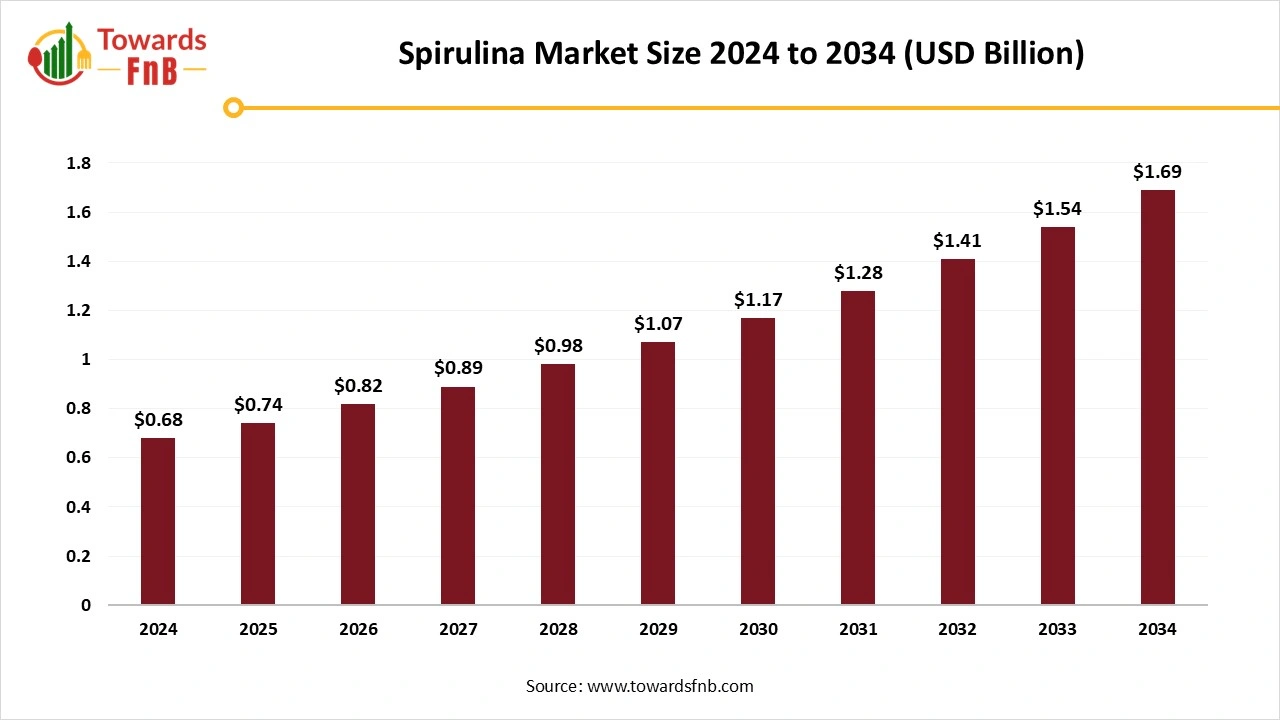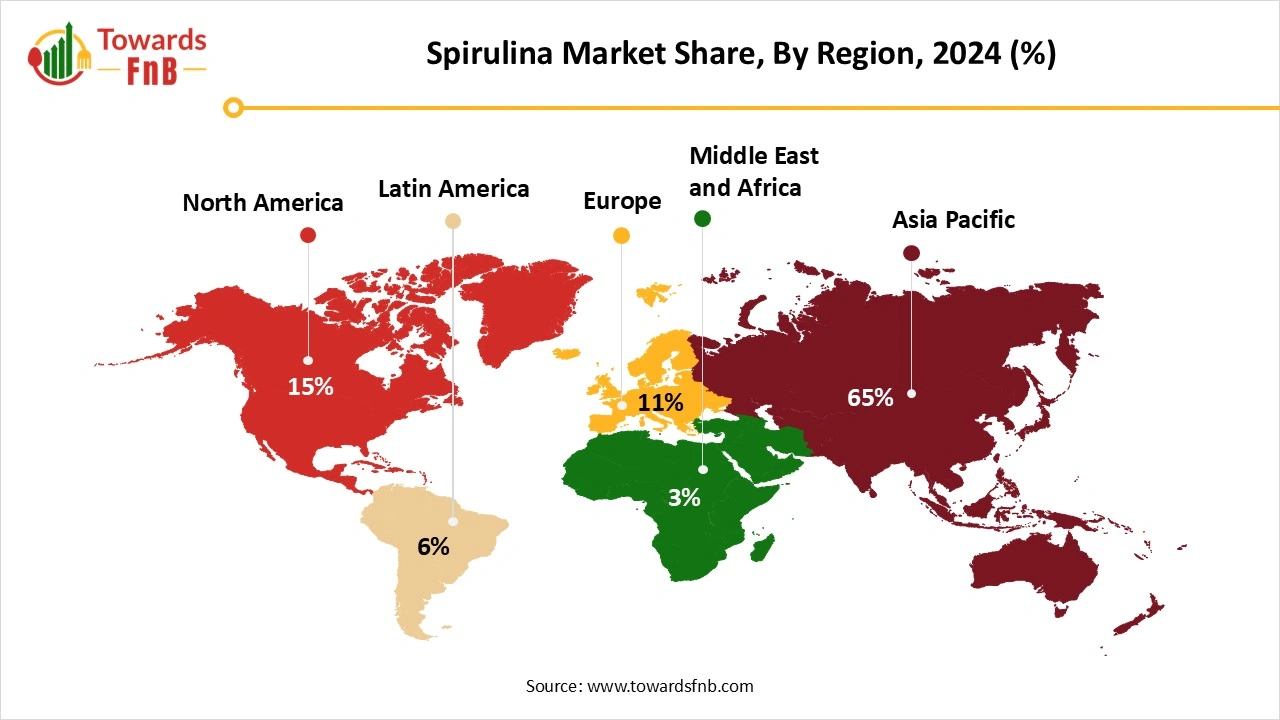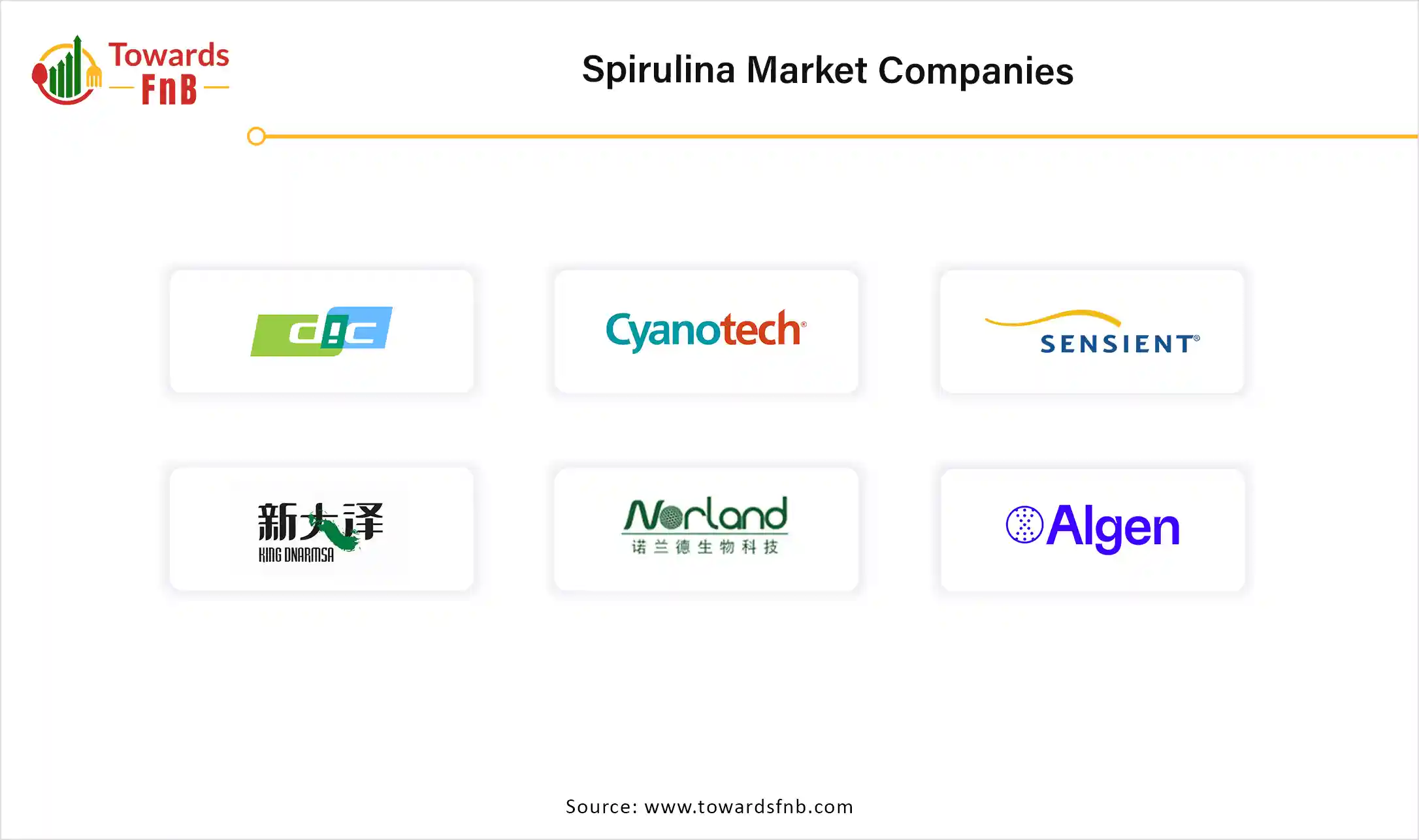December 2025
The global spirulina market size was reached at USD 0.68 billion in 2024 and is expected to grow steadily from USD 0.74 billion in 2025 to reach nearly USD 1.69 billion by 2034, with a CAGR of 9.5% during the forecast period from 2025 to 2034. Rising demand for health and wellness, demand for dietary supplements and alternative protein source along with growing vegan population significantly driving the market.

| Study Coverage | Details |
| Growth Rate from 2025 to 2034 | CAGR of 9.5% |
| Market Size in 2025 | USD 0.74 Billion |
| Market Size in 2026 | USD 0.82 Billion |
| Market Size by 2034 | USD 1.69 Billion |
| Largest Market | Asia Pacific |
| Base Year | 2024 |
| Forecast Period | 2025 to 2034 |
| Regions Covered | North America, Europe, Asia-Pacific, Latin America, and Middle East & Africa |
Spirulina is a blue-green algae (cyanobacteria) consumed as a dietary supplement or functional ingredient. It is rich in protein, vitamins, antioxidants, and minerals. Spirulina is cultivated primarily in controlled aquatic environments and is used across food & beverages, nutraceuticals, cosmetics, and animal feed industries due to its nutritional and health benefits. The growing popularity of Spirulina is due to a growing demand but also from general acceptance as a protein alternative and a healthier and more sustainable source of food.
There are possibilities for creating novel spirulina-derived products, including snacks, drinks, and functional food. This accommodates various consumer tastes and integrates spirulina into everyday eating habits. The antioxidant and anti-inflammatory characteristics of spirulina provide possibilities for its use in skincare and cosmetic products. Moreover, spirulina is becoming a potential biomass raw material for producing biofuels. It offers a feasible alternative for biodiesel because of its sustainability and lack of competition with food supplies.
As the global population increases, fossil fuel depletion, environmental concerns, and volatile crude oil prices are driving interest in biofuels as a renewable energy option. Advancements in technology, including photobioreactors and controlled environment systems, have simplified cultivation, making spirulina production more affordable and accessible, thereby creating new opportunities for farmers and businesses globally.
Variations in temperature, water quality, and other environmental factors can influence spirulina farming and production, resulting in supply inconsistencies and possibly hindering market expansion. The large-scale production of Spirulina encounters several challenges such as significant water usage and the presence of algal pathogens, predators, and grazers. Mass cultivation in open pond systems renders it vulnerable to numerous contaminants, threatening product quality and production efficiency.
Asia Pacific Dominated the Spirulina Market in 2024.
The increasing occurrence of chronic illnesses in Asia Pacific, like diabetes and chronic kidney disease, is boosting the demand for spirulina extracts. The number of adults with diabetes is projected to rise from 398 million in 2019 to 463 million by the year 2030. This heightened awareness is fueling demand as more individuals pursue natural, nutrient-rich supplements to enhance their overall health, immune function, and energy, thereby accelerating the expansion of the spirulina extract market. The rising vegan and vegetarian community in the Asia Pacific area is boosting the need for spirulina extract, aligning with plant-based dietary choices. Nations such as India, China, and Thailand are becoming important production centers, with increasing local demand for spirulina as a functional food and dietary supplement.

India Spirulina Market Trends
The India spirulina market is undergoing notable expansion fueled by heightened awareness of the health advantages linked to spirulina, including its substantial protein levels and abundant nutrient composition. The growing preference for plant-based diets in India has increased the demand for spirulina, in line with government backing for health and wellness programs. Moreover, as an increasing number of people learn about dietary supplements, spirulina's status as a natural superfood has gained significant popularity. The Indian government has initiated multiple programs to promote the growth of spirulina due to its recognized significance. Farmers looking to grow spirulina can obtain training programs, incentives, and technical assistance from different agricultural agencies and research organizations.
Spirulina Producing Industries in India
Throughout India, numerous Spirulina production firms have been set up in response to the swiftly growing commercial demand for the algae. One such company is E.I.D. Parry Limited, a major corporation that has established a facility for Spirulina production in Tamil Nadu. The firm cultivates Spirulina in a regulated environment and offers a range of Spirulina-based products sold both locally and internationally. Vinayak Ingredients Limited is another company that produces food ingredients and includes Spirulina in its range of products. It is a cutting-edge enterprise that maintains rigorous quality standards to ensure their Spirulina products are effective and secure. Nutra Helix Biotech Pvt. Limited employs advanced technologies to improve Spirulina cultivation and quality of production.
Latin America Expects Considerable Expansion Throughout the Forecast Period.
Increasing awareness of health and wellness will drive the Latin America spirulina market forward. Spirulina Viva conducts workshops aimed at small to medium-sized producers who want to cultivate spirulina. Producers from Argentina, Peru, Colombia, Mexico, and Brazil have already been trained. The increasing interest in natural and clean label ingredients has revived the demand for spirulina protein. Strict regulations and restrictions on synthetic additives have created a surge in the need for natural ingredients. Considering the application fields, the nutraceutical and food industries are anticipated to be key consumers of spirulina, driven by the swift growth of algae-derived superfoods and increased consumer demand for natural and clean-label items.
Which Product Type Dominated the Spirulina Market in 2024?
Arthrospira platensis segment led the spirulina market in 2024. Arthrospira platensis prevails because of its better nutritional qualities, especially its increased protein levels, and simple cultivation. This renders it a favored option for health-aware buyers and economical for manufacturers. Its simple cultivation and harvesting process makes it a more cost-effective choice for producers, resulting in greater availability and reduced prices for consumers. A study by the USFDA has shown that Arthrospores Platensis is rich in calcium, niacin, potassium, magnesium, B vitamins, and iron.
Arthrospira Maxima Segment is Observed to Grow at the Fastest Rate During the Forecast Period.
Arthrospira maxima has elevated levels of specific amino acids, rendering it an important protein source, especially for animal feed and aquaculture uses. This strain contains more chlorophyll, which adds to its unique green hue and provides extra health advantages. The need for Arthrospira maxima is increasing, especially in specialized markets that require its distinctive nutritional advantages.
Why Powder Form Dominated the Spirulina Market in 2024?
Powder segment held the dominating share of the spirulina market in 2024. Its powdered state facilitates easy mixing and ingestion, making it a favored option among consumers. Spirulina powder finds application in numerous products, such as nutraceuticals, cosmetics, and animal feed, enhancing its market presence. Spirulina powder can be effortlessly incorporated into smoothies, energy bars, protein shakes, and various food and drink items.
Liquid Segment is Seen to Grow at a Notable Rate During the Predicted Timeframe.
Liquid spirulina extract is utilized not only in food and drink but also in cosmetics and personal care items. Its adaptability enables its integration into various products, thus enhancing its expanding market. Liquid spirulina extract might also provide enhanced absorption and simpler integration into formulations, making it attractive for manufacturers aiming to develop innovative products.
How did Conventional Form Dominate the Spirulina Market in 2024?
Conventional segment dominated the market with the largest share in 2024. Traditional spirulina farming, utilizing conventional techniques, generally has reduced input expenses compared to organic practices which has boosted the demand of the conventional spirulina. This is mainly a result of employing synthetic fertilizers and pesticides in the traditional method. Conventional farming techniques frequently result in greater yields and enhanced availability of spirulina, thereby aiding in its reduced price and broader accessibility.
Organic Segment is Expected to Grow at the Fastest Rate in the Market During the Forecast Period.
This expansion is primarily fueled by the rising demand for plant-based supplements, motivated by health-minded consumers in search of natural, nutrient-dense products. The rise in popularity of spirulina can be attributed to its abundant protein, antioxidants, and anti-inflammatory characteristics, rendering it a highly desired component in dietary supplements, food items, and cosmetics. Moreover, the increasing global vegan and vegetarian community is anticipated to enhance the need for organic spirulina as a natural nutritional source.
Which Distribution Channel Held the Largest Share of the Spirulina Market in 2024?
B2B segment held the largest share of the market in 2024. The B2B segment dominates the distribution channel because producers in sectors like animal feed, food and beverage, and nutraceuticals buy spirulina in large quantities. The B2B sector flourishes through the direct provision of substantial amounts of spirulina to producers and processors. This efficient method guarantees a steady supply for sectors that depend on spirulina for their goods. The direct acquisition of premium spirulina from vendors enhances effective supply chain management and ensures product uniformity.
Online Retail Segment is Observed to Grow at the Fastest Rate During the Forecast Period.
Growth is motivated by the growing consumer desire for convenience and the simple access to various spirulina powder products. Online shopping platforms like Amazon, health-oriented e-retailers, and brand sites enable customers to buy spirulina powder straight from producers or third-party vendors. E-commerce is especially appealing because it can connect with a worldwide audience and offer comprehensive product details, consumer feedback, and competitive pricing. Health influencers and social media sites are essential in informing consumers about spirulina and its advantages, which enhances online sales.
Why Nutraceuticals Segment Dominated the Spirulina Market in 2024?
Nutraceuticals segment dominated the market with the largest share in 2024. The increase in the aging population, prevalence of lifestyle-related diseases, and the need for clean-label, organic products are driving the demand for nutraceuticals in this area. It's a typical component in vitamins, protein powders, and various supplements aimed at weight control, immune enhancement, and general health. The nutritional characteristics of spirulina render it a significant component in functional foods and drinks, consequently promoting its integration within the nutraceutical sector.
Cosmetics & Personal Care Segment is Seen to Grow at a Notable CAGR During the Predicted Timeframe.
Spirulina, noted for its high levels of proteins, vitamins, and antioxidants, is especially appreciated for its skin-enhancing attributes, which contribute to its frequent use in anti-aging creams, moisturizers, serums, and face masks. The increasing number of consumers opting for vegan, cruelty-free, and organic beauty products, along with heightened awareness of the advantages provided by microalgae in cosmetic and personal care items such as skin care, hair care, and hygiene products, are all elements driving the growth of the global market.
Which Cultivation Technology Dominated the Spirulina Market in 2024?
Open Pond Cultivation segment led the market by holding the largest share in 2024. Open pond systems, particularly raceway ponds, are preferred due to their lower initial investment and operational expenses when compared to closed photobioreactors. Open pond systems are ideal for extensive spirulina cultivation, with commercial ponds typically varying from 500 to 5000 m², based on a model bankable project report by NABARD. Recent progress involves improvements in pond design, including the application of concrete or plastic-lined ponds and the adoption of covered systems to enhance temperature regulation and minimize contamination. These innovations are enhancing the efficiency and reliability of open pond systems for large-scale spirulina cultivation.
Photobioreactors Segment is Expected to Grow at the Fastest CAGR in the Market During the Forecast Period.
Photobioreactors enable accurate regulation of elements such as light, temperature, CO2, and nutrient concentrations, resulting in more uniform and increased biomass output. Photobioreactors present substantial opportunities for automation, which could enhance cultivation management and effectiveness. Photobioreactors are set for considerable expansion owing to their capacity for improved regulation of cultivation variables and possibly greater yields, particularly for specialized uses such as phycocyanin production.
Which Processing Technology Held the Dominating Share of the Spirulina Market in 2024?
Spray drying segment held the dominating share of the spirulina market in 2024. Spray drying is a mild technique that aids in maintaining the nutritional value of spirulina, keeping vital vitamins, minerals, and proteins intact. Spray-dried spirulina powder exhibits excellent shelf stability, making it suitable for items with extended shelf lives. Researchers are consistently striving to enhance spray drying conditions (like inlet temperature and carrier substance) to boost the quality and output of the produced spirulina powder.
Freeze Drying Segment is Observed to Grow at the Fastest CAGR During the Forecast Period.
Freeze-drying preserves the quality and quantity of bioactive compounds in spirulina by reducing heat and oxidation damage during drying. Advancements in freeze-drying technology are facilitating the creation of high-quality, fine-textured powders that offer excellent solubility and bioavailability.
Which End Use Industry Held The Largest Share of the Spirulina Market In 2024?
Health & wellness segment held the largest share of the market in 2024. Increasing fascination with preventative healthcare, as individuals look for methods to preserve wellness and prevent sickness. the elderly demographic and the rising interest in healthy aging have fueled the need for products and services that tackle age-related issues and encourage healthy aging. Spirulina's abundant nutritional content, featuring protein, vitamins, minerals, and antioxidants such as phycocyanin, has made it a favored option for those looking for natural health alternatives. The antioxidant and skin-repairing benefits of spirulina are employed in cosmetics and personal care items, especially within the clean beauty sector.
Aquaculture Segment is Expected to Grow at the Fastest Rate in the Market During the Forecast Period.
Increasing expenses and sustainability issues related to conventional fishmeal and fish oil have pushed aquaculture to seek alternative protein sources. Spirulina, known for its elevated protein levels (58-70%), is a potential alternative. It serves as a substitute or supplement to fishmeal in fish feed, providing a protein-dense, affordable, and eco-friendly choice for aquaculture. Moreover, spirulina enhances fish health, promotes growth, and boosts disease resistance, in addition to aiding in the purification of wastewater from aquaculture activities.
SimpliiGood

By Product Type
By Form
By Nature
By Distribution Channel
By Application
By Cultivation Technology
By Processing Technology
By End Use Industry
By Region
December 2025
December 2025
December 2025
December 2025